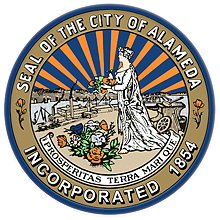
On this page:
- Design Guidelines
- What is Design Review?
- What kinds of projects are subject to Design Review?
- Work that is exempt from Design Review
- What design criteria are used to evaluate my project?
- Who gets to review my plans and how are they notified?
Design Guidelines
- Design Review Manual Part 1
- Design Review Manual Part 2
- Design Review Manual Part 3
- Exterior Paint Guidelines for Alameda Point Historic District
- Guide to Residential Design
- Guide to Residential Design-Ranch Style Houses
- Webster Street Design Manual
- Park Street Gateway District Strategic Plan
- Window Replacement Design Guidelines
What is Design Review?#
The general aim of the Design Review process is to ensure that new construction and remodeling in Alameda is attractive, safe and harmonious with its surroundings. The intent of the process is preserve the city's architectural heritage, aesthetic values, residential character and natural beauty.
The information below provides a general summary of Design Review regulations in the City of Alameda. Reading this page can save you time, answer some of your questions about Design Review, and help you navigate the Design Review process. Keep in mind that this is a summary only. For a complete description of Design Review requirements, please review Section 30-37 of the Zoning Ordinance on Design Review and the Guide to Residential Design.
What kinds of projects are subject to Design Review?
The City requires Design Review on all exterior construction work that requires a building permit unless the work is specifically listed on the list of Design Review Exemptions. Examples of typical projects subject to Design Review include:
- New buildings, garages or carports
- Room additions and accessory structures over 220 square feet in size
- Upper-story additions
- New or expanded decks above the first story
- New or enlarged windows
- Any modification to the exterior that is not a visual match to the existing appearance
Design Review may be required for certain improvements that don't require building permits, such as fences over 4 feet tall in a front yard. Check with the Planning staff before proceeding.
Work that is exempt from Design Review
Design Review is not required for:
- Work that does not require a building permit
- Interior remodeling that does not require changing the exterior of the building
- Landscaping with plant materials
- Painting of existing buildings
- Normal repair, replacement and maintenance of existing construction, as long as it is an exact replacement (no change in style, material, size, etc.) This is often referred to as “replacement in-kind.”
- Replacement-in-kind of accessory structures, such as garden sheds, that are less than 220 square feet in size
- Fences
- Restoration of architectural elements on a building to its original appearance. For example, restoring the ornamental balustrade (railing assembly) on the front stairs of a Victorian to match its appearance at the time of construction would be exempt from Design Review. In cases where the entire architectural style of a building has been completely renovated into a new style, changes to the exterior that are consistent with the current appearance are also exempt from Design Review provided the work is consistent with the Guide to Residential Design.
- Reroofing, when no structural alteration will take place
- Any addition or improvement that is:
- less than 220 square feet in size, and
- located on the first story as defined by the Building Code, and
- located in the rear yard area, and
- meets all applicable lot coverage, open space, and setback requirements in the Zoning Code, and;
- all exterior materials, architectural detailing, roof pitch and design, windows, and doors are a visual match to the existing, or a restoration of architectural elements to its original appearance.
- Foundation work
- New or refaced signs with approved sign permits and signs that meet the requirements of an approved sign program
- New awnings that meet all of the following criteria:
- Are covered in an opaque, non-glossy fade and fire-resistant fabric material;
- Match the alignment and shape of any existing awning on the same level of the building;
- Do not cover transom windows or extend more than 6 inches beyond the perimeter of a window, door or other opening;
- Exhibit a slanted or, if over arched windows or individual upper floor windows, a domed shape;
- Are not placed over pilasters, columns or other prominent vertical elements;
- Are not internally illuminated;
- Provide a minimum of 8 feet of vertical clearance for framed portions and 7 feet for any unframed valances;
- Have all required encroachment permits from the Public Works Department.
- Awnings with approval by the City of Alameda Facade Improvement Program
- Docks that meet City standards
- New solar collection systems or skylights
- Second units or “granny units” meeting the requirements of Alameda Municipal Code Section 30-4.1
- Changes to an existing parking lot, provided that the lot is not visible from the public right-of-way and the number of parking spaces or the area of landscaping are not being reduced.
Depending on the specific details of your projects, other improvements may also be exempt. Check with Planning staff before proceeding.
What design criteria are used to evaluate my project?
Section 30-37 of the Alameda Municipal Code specifies three findings (criteria) for evaluating projects. These generally relate to meeting requirements of the zoning ordinance and the aesthetics, compatibility and safety of the project. In addition, the City adopted a Guide to Residential Design that considers the appropriateness of your project from three different perspectives:
1) How your project fits into the neighborhood context
2) How your project fits with the existing site/building
3) Whether your project seeks to preserve or restore original elements
Other design guidelines may apply to your project. Please consult the Counter Planner for more information.
Who gets to review my plans and how are they notified?
Your plans are kept on file at the Permit Center and may be reviewed by any interested member of the public. The City also sends a letter to the owners of all properties within 100 feet of your property, informing them of the project and the availability of the plans for review either in the Permit Center or on the City’s website. You may also be asked by the project Planner to post a copy of the notice on your property as a notification sign for the neighborhood.






